|
- Team Losi Racing 22T 2.0 - Review -
Words & Photos BY JOEL NAVARRO
The reigning ROAR champ is honed for even better Main-making performance
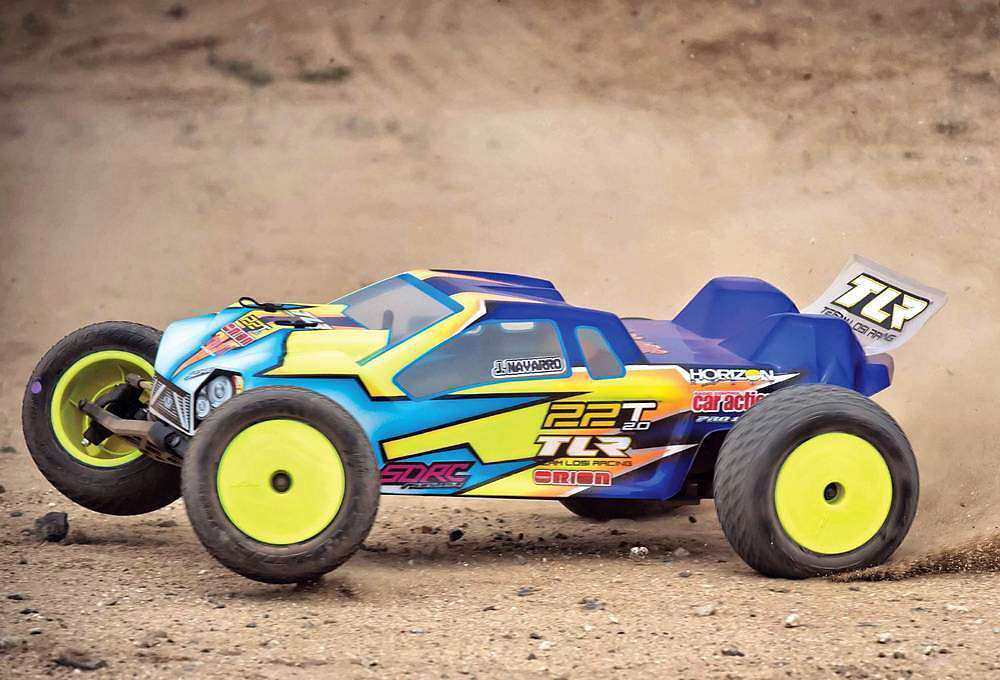
Team Losi was the first to offer a purpose-built competition stadium truck when the JRX-T rolled onto tracks way back in 1989. With each iteration of Losi’s top 2WD platform since then, a new stadium truck has followed, and the brand now known as TLR (Team Losi Racing) has always been a top contender in any stadium truck battle, local to national. TLR builds on its rich truck racing heritage with the new 22T 2.0, an even more refined version of the 22T architecture that Dakotah Phend drove to his current ROAR 2WD Truck champion title. The new 2.0 model adds enhancements that include updated suspension geometry and a new steering system, all designed to shave tenths at the track. With this years 1/10 scale electric ROAR Nationals quickly approaching, the truck you see here could well be the 2015 ROAR champ as well? Lets see how 22T 2.0 does on the track.
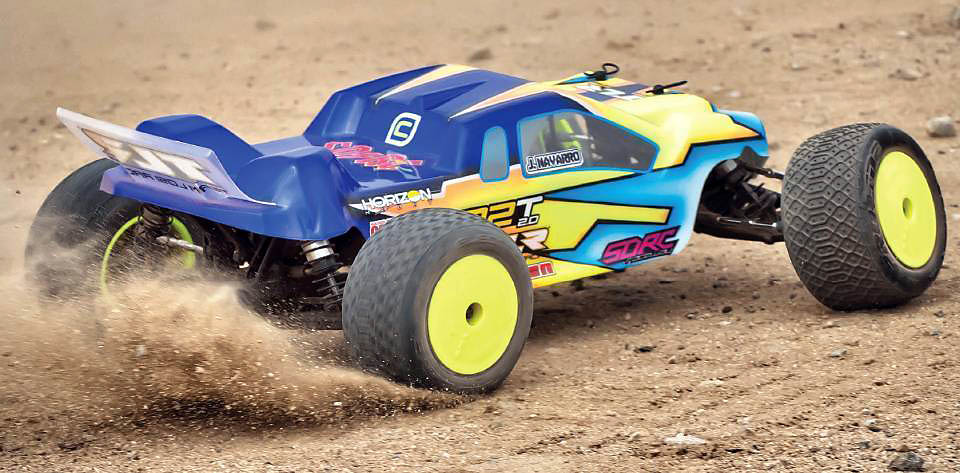
MID- AND REAR-MOTOR CONFIGURATIONS
The TLR crew saves you the trouble of buying extra parts or cars when it comes to deciding if you want to make your 22T 2.0 a rear- or mid-motor truck. All the parts for both configurations are included in the box, right down to configuration-specific Lexan bodies. Additions to the 2.0 truck include TLR’s Heavy Duty Slipper (HDS) with a new pad and pressure plate design. The pads have greater surface area to help you fine tune the clutch’s sweet spot, and the plates are now tapered to offer a more consistent shape and flat surface area. Eight grooves on the slipper plates help clean debris off the pad, letting gunk exit through the grooves. The ball differential has also received the 2.0 treatment. The outdrives and diff rings are ground for an ultra-flat finish, and tungsten carbide diff and thrust balls have offered smoother action than standard steel balls. Steel CV-style driveshafts capped by plastic 12mm hex hubs complete the drivetrain, and the front and rear wheels are interchangeable.
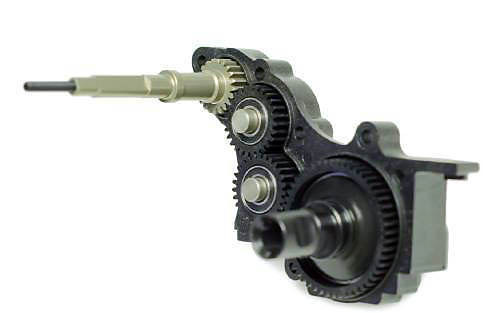
The transmission uses a lightweight aluminum top shaft to help reduce rotating mass. The 4-gear configuration is for mid-motor use; an additional gearbox is supplied for a 3-gear, rear-motor setup.
|
|
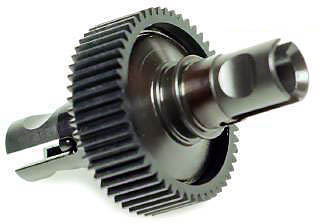
The 2.0’s ball differential design is unchanged, but manufacturing refinements and tungsten diff and thrust balls give it even smoother action.
|
GENERATION II SHOCKS
Shocks are one of the most important parts of an off-road car and influences its handling and the Gen II shocks are second to none. The rear shock bodies and shaft are now longer to allow more travel and should give the truck more suspension reach in rough terrain and improve landings. To provide smooth action, the pistons and bushing guides are machined for maximum precision. The shock shafts have been coated with a Ti-Carbo-nitride finish that slides smoothly on the new silicone X-rings which together minimize friction and stiction. Up top, TLR includes aluminum shock caps with bleeder screws to help you bleed the shocks perfectly.
UPDATED ALUMINUM CHASSIS
TLR didn’t make too many changes to the chassis as they felt the performance it yielded was superlative already. Length and component positions are unchanged, as team drivers thought the 22T offered a perfect balance of traction and agility. In the battery compartment section, the new chassis uses shorter foam strips in the area where most users ran shorty type batteries and added holes in the chassis to allow for more battery locations to fine-tune the weight distribution. Just like the 22 2.0 buggy, the 22T now uses a small screw that holds the anti-squat block in place for when you are doing drivetrain maintenance that requires you to remove the gearbox.
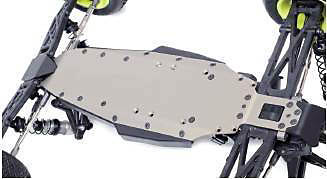
Additional holes in the battery area now make it easier fit any type of battery you may want to use.
|
|
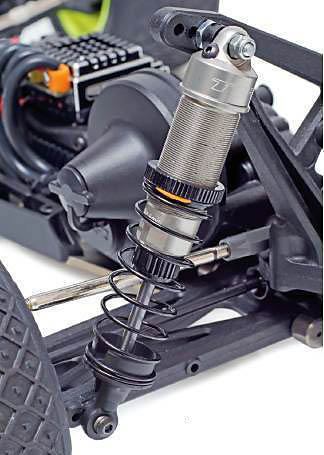
The Gen II shocks are TLR’s smoothest and most precise dampers yet.
|
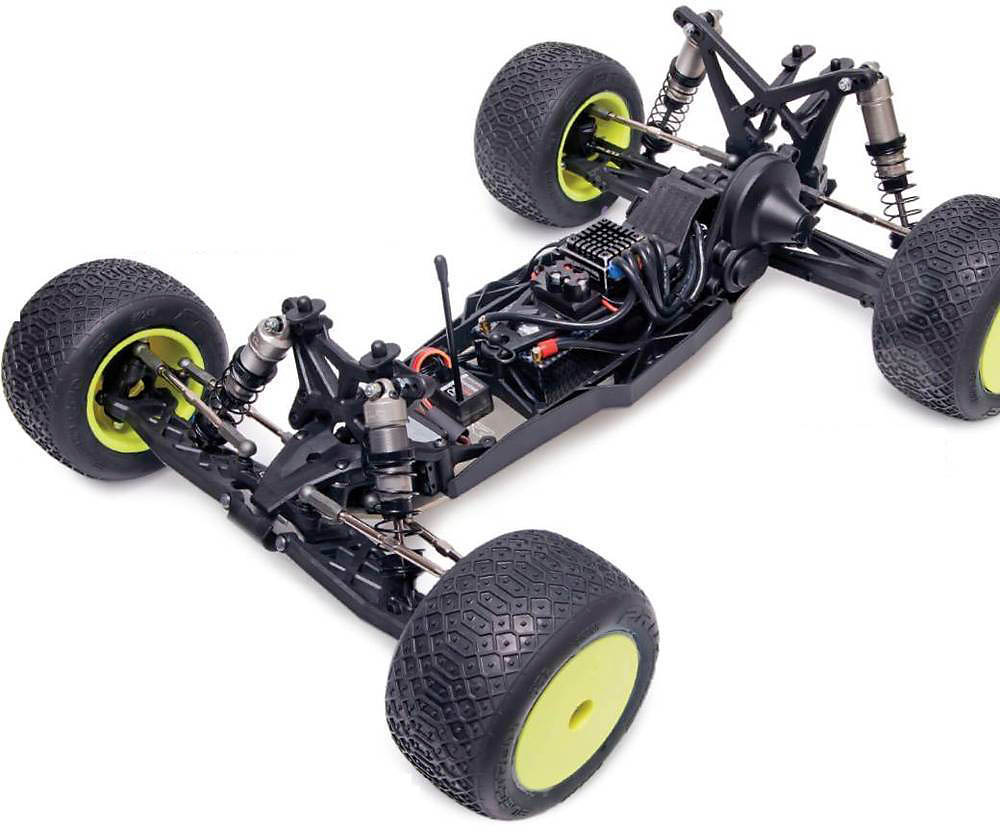
The 2.0 doesn’t appear different from the previous 22T at a glance—it’s all about the details.
VERSION 2.0 SUSPENSION
One of the biggest changes TLR engineers implemented was to the suspension. Starting with the front end of the 22T, the 2.0 updates include the caster blocks that are used on the 2.0 buggy and short course truck with spindles that are specific to the 22T 2.0. The new spindles change the location of the steering linkage ball stud to get the correct ackerman to work in harmony with the new bellcrank steering parts and the now incorporates 2mm of trailing axle (the old spindle was inline). In the rear, longer suspension arms are used with shorter hexes. The overall width is the same as the original 22T, but the center of the wheel is now closer to the outside arm hinge pin. This change helps the truck carry off power speed in turns and helps weight transfer easier to the rear when you get back on the throttle. The rear arms themselves received an additional inner shock mount hole to allow softer suspension settings.
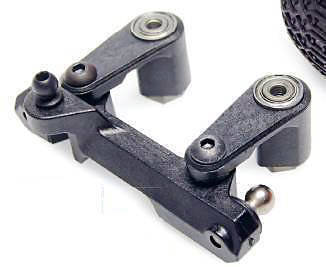
Gone is the slider steering system. The new bellcrank units make the 22T 2.0 easier to drive hard into turns and to exit.
|
|
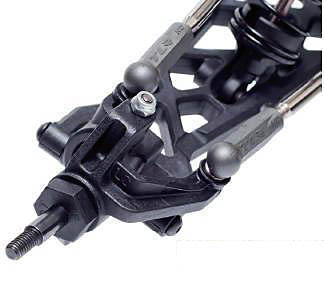
The new caster blocks and 22T 2.0 specific spindles make the truck easier to drive fast.
|
BEHIND THE WHEEL
My day of testing with the 22T 2.0 started off with a visit to the track on SDRC Raceway’s Friday Night Fights weekly race program. I quickly referred to the manual’s box stock set up which had me set the ride height at 30.5mm in the front and 29mm in the rear. With a couple turns of the camber links, I dialed in the manual’s recommended negative 1-degree front and negative 1.5-degree rear camber. With clean tires and no tire sauce, I threw the 2.0 on the track for its first battery pack. The Pro-Line Electron tires I installed immediately found traction, which was a nice surprise considering the new track layout had only been installed three days before. The 2.0 was an easy truck to navigate around the track and was working in great harmony with the available power from the Orion 10.5-turn motor I had installed. As I turned more laps with the 2.0, all the springs on the truck were starting to settle in, and back at the pit I readjusted the ball differential and checked my ride height settings. With the race schedule quickly approaching, I prepped the truck in a similar fashion as I would be for racing. I decided to sauce the tires this time with adding the tire additive to the whole width of the rear tires and only to the inside half of the fronts. As the tires broke in and scrubbed into the suspension settings, the 2.0 started to feel like it was on rails. The 22T’s wide stance gave it an overall stable feel that inspired confidence to drive the 2.0 faster and faster with every lap I took. Initial off-power turn-in was amazing as the 2.0 effortlessly shaped perfect turns that I could alter with slight to bigger throttle inputs. There were a couple of jumps on the track with a short run up area that I was having trouble clearing. After a few close passes I could hear what the trouble was, a loose slipper clutch. With some quick turns of the slipper clutch adjustment nut, the 22T was jumping like a champ. There wasn’t a jump take off on the track that could upset the 2.0 as it would launch in the air perfectly every time. Once in the air, the 22T jumped with a perfect level attitude with heavy influence from the fat stadium truck tires—you tapped the brakes or stabbed the throttle if you wanted a nose up or down attitude. Controlled landings were easy thanks to the plush suspension and big tires that cushioned enough that the chassis never slapped on the ground. So how did the 22T 2.0 do on race night? It took the TQ position on the grid and allowed me to capture the overall win. The only broken piece throughout testing was a stripped servo horn, which I replaced with an aluminum one.
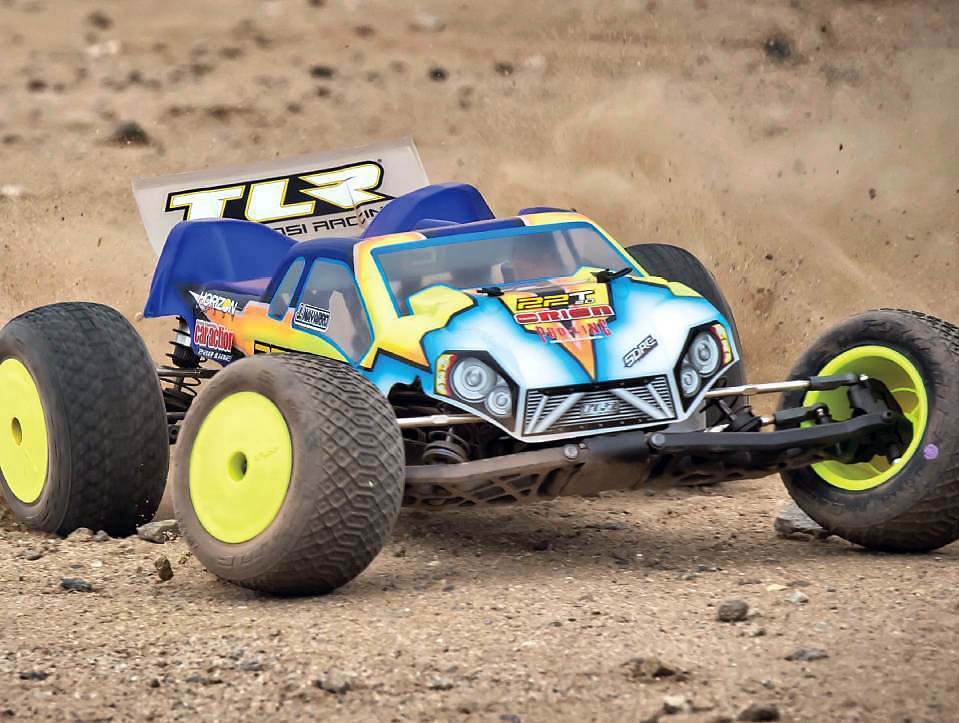
FINAL WORD
TLR pushes the boundaries when it comes to all-out performance on the track. When factory pilot Dakotah Phend captured a National title with the original 22T, that didn’t mean that engineers and team driver were going to stop pushing for ways to make the truck faster. I can confidently say that the 22T 2.0 hits the mark the TLR engineers were aiming for. In a single night of racing with box stock settings, the 22T 2.0 allowed me to successfully capture the modified truck TQ and overall win. With this kind of success in the hands of a club racer, I look forward to see what it’ll do at this year’s Nationals.
VEHICLE SPECS
Item no.: TLR03004
Scale: 1/10
Price: $ 300
Weight, as tested: 4 lb., 15 oz. (1883g)
CHASSIS
Material: Hard-anodized machined aluminum
Type: Plate with plastic side guards
SUSPENSION
Type: Lower H-arm with turnbuckle camber link
Inboard camber link positions (F/R): 2/2
Outboard upper arm positions (F/R): 2/4
Shock positions, towers (F/R): 3/4
Shock positions, arms (F/R): 2/3
SHOCKS
Bodies: Threaded aluminum, 12 mm bore
Shafts: coated steel, 3mm
Volume compensation: Emulsion
DRIVETRAIN
Type: 2WD enclosed gearbox
Spur gear/pinion: 82T / Not included (21-tooth used)
Differential: Ball
Driveshafts: Steel CV-style
Bearings: Rubber sealed
WHEELS & TIRES
Wheels: One-piece plastic dish, 12mm hex
Tires: Not included
Test Gear (Not Included) Radio: Spektrum DX4R Pro
Receiver: SR2000 DSMR Micro Race Receiver
Speed Control: Orion Vortex R10.1 Pro
Motor: Orion Vortex VST2X Pro 10.5-turn 540 type
Servo: Spektrum S6070 Low Profile
Battery: Orion 4500 Carbon Pro 100C 7.4V 2S
Tires: Pro-Line Electron 2.2, Clay compound
Charger: Hitec X1 Pro DC/DC Multi-Charger/Hitec ePowerBox 17-amp Power Supply
Paint: C-Built Designs
|
|
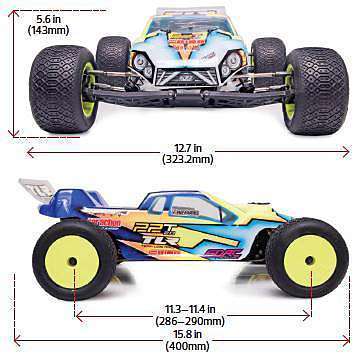
SOURCES
C-Built Designs cbuiltdesigns.com
Hitec hitecrcd.com
Orion teamorion.com
Proline prolineracing.com
Spektrum spektrumrc.com
Team Losi Racing tlracing.com
+
All parts required for mid- and rear-motor setup are provided, including bodies
Excellent cornering
Exceptional jumping performance
Easy to drive fast
-
Plastic servo horn stripped |
|
